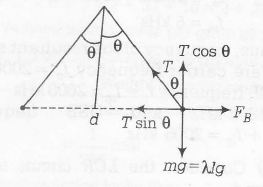Answer:
Option B
Explanation:
Consider free body diagram of the wire.
As the wires are in equilibrium, they must carry current in the opposite direction

Here, $F_{B}=\frac{\mu_{0}I^{2}l}{2\pi d}$, where l is length of each wire and d is separation between wires.
From figure, $d=2L \sin\theta$
$T=\cos\theta=mg=\lambda lg$ (in vertical direction) ......(i)
$T \sin\theta=F_{B}=\frac{\mu_{0}I^{2}l}{4\pi L\sin\theta}$
( in horizontal direction 0 .....(ii)
From Eqs. (i) and (ii)
$\frac{T \sin\theta}{T\cos\theta}=\frac{\mu_{0}I^{2}l}{4\pi L\sin\theta\times\lambda lg}$
$\therefore$ $I= \sqrt{\frac{4\pi\lambda L g \sin^{2}\theta}{\mu_{0}\cos\theta}}$
$=2\sin\theta \sqrt{\frac{\pi\lambda Lg}{\mu_{0}\cos\theta}}$